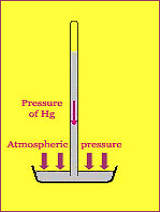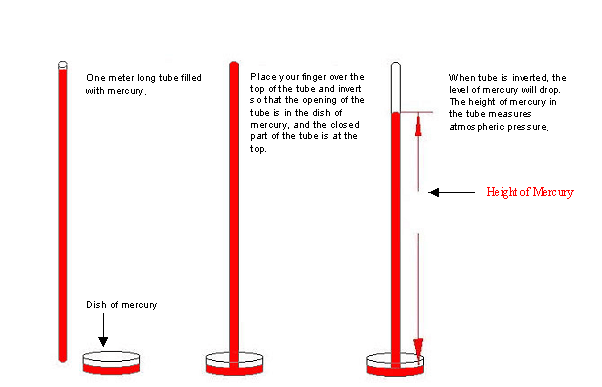Air Pressure Curriculum
Section 1—Lesson 2: When Non-obvious Causes Become Obvious
Lesson Plan
Materials
- Jars that the students set up in Lesson 1
- Atomic Microscope 3-D available at http://www.starkdesign.com/products/ or Virtual Molecular Dynamics Laboratory available at http://argento.bu.edu/vmd/
- Approximately 14 balloons
- 14 one-foot pieces of tubing that fit into the balloons
- Two tables of about the same size
Prep Step
- Review the lesson plan, background information, and understanding goals.
Note to Teacher: Try to do this lesson during a week with variable weather.
Analyze Thinking
Step 1: Considering When We Do Notice Air Pressure
Ask the class the following questions about air pressure:
- Why is air pressure so hard to notice? (It is hard to notice because it is non-obvious; it is always around us, yet we can't see it, etc.)
- When are times when we do notice air pressure? (Usually we only notice it when it causes something that we do not expect, or something that is so obvious that we have to try to figure out what caused it. For instance, when our ears are suddenly hurting and pop, we look for a cause. Often, we fail to notice air pressure until it changes in some way or is no longer there. Since we live in an ocean of air, we are used to air pressure because it's all we have ever known.)
RECAST Thinking
Step 2: Observing the Height of a Liquid in a Tube Over Time
Over the next several days to a week, have students observe the liquid in the straw that they set up in Lesson 1. Make sure students think about the following:
- Look at where they marked the level of the oil in the straw. What happens to the level of the oil? (It should fluctuate.)
- What ideas do they have regarding the fluctuation?
Step 3: Discuss What Students Observe Happening in the Straws
Discuss what students think is going on with the liquid in the straw. Ask: "What do you think is causing the liquid to rise and fall over time?" (Students might mention obvious causes such as changes in weather or evaporation of the liquid in the jar. They might also mention non-obvious causes such as air pressure.)
Step 4: Visualizing Air Pressure
If students have not mentioned air pressure, introduce the concept. Ask if they have heard of air pressure. Collect a few ideas. Ask them to draw a model showing what air pressure is and how it works (on individual white boards, in their journals, or on a blank sheet of paper). Give at least 10 minutes for students to think about and develop their models. Encourage students to use the process of model drawing to think through their current assumptions about air pressure. Afterwards, discuss students' models. Make sure that the following ideas are introduced into the conversation.
- Many individual molecules that make up air are bouncing around.
- Each molecule applies a force perpendicular to the surface that it hits.
- The collective result of all of these bouncing molecules is air pressure. (The result is pressure, not force because the force is spread over the surface area of the objects the individual molecules hit.)
- The more molecules bouncing around and the faster they move (the more kinetic energy), the greater the air pressure. The fewer the molecules and the slower they move, the lesser the air pressure.
- It can be challenging to visualize air pressure. Pressure is the force per unit of surface area, where the force is applied perpendicularly to the surface area (Pressure=Force/Area). In order to visualize air pressure, you have to envision numerous bouncing molecules each applying forces against any surface with which they have contact resulting in air pressure.
A good way to help students visualize air pressure as scientists do is to use one of the molecular visualization programs available on the web, for instance, Atomic Microscope 3-D available at http://www.starkdesign.com/products/ or Virtual Molecular Dynamics Laboratory available at http://argento.bu.edu/vmd/.
Step 5: Evidence for Air Pressure: Lifting a Table With Balloons
Say to the students: "The Torricelli experiment and the barometer activity are intended to convince you that air exists (takes up space) and that it exerts pressure. Do you believe it? What evidence can you think of that supports the assertion?" Gather ideas. Then ask: "Is there any evidence that contradicts the assertion?" Gather ideas.
Do the following demonstration:
Place uninflated balloons with tubes to blow into them every foot or so (depending upon the weight of the second table) around the perimeter of a rectangular table. (The tubes are important for safety, to keep the students back far enough from the table, should it fall.) Invert a second table (the smaller table of the two), face down, on the one below, so that the open ends of the tubes are all protruding out from between the tables. Have students volunteer to blow, all at the same time, into each balloon, to see if they can lift the inverted table. Assign students to act as spotters to keep the table from shifting.4
Discuss what happened. Ask, "Does this provide convincing evidence that air exists and that it exerts pressure? Is it convincing to you or not?" Then ask, "Can you think of other ways to demonstrate that air exists (takes up space) and exerts pressure?"
Explore Causality
Step 6: Discuss How Changes in Non-obvious Causes Can Reveal Their Existence
Ask students to consider what the fluctuations in the straw tell them about noticing non-obvious causes. Ask: "When are we likely to notice the effects of air pressure?" (When the air pressure changes, such as when the weather changes from sunny to rainy. If they observed the jars over a long period of time, they would start to notice that the changes in the liquid corresponded to changes in the weather.)
Read the following passage to the students:

In 1648, Blaise Pascal confirmed Torricelli's idea of the variability of air pressure. Pascal brought a tube with mercury, like the one Torricelli used (which came to be known as a Torricelli Tube), from sea level to the top of a mountain. Notice that the Torricelli Tube consists of a tube inverted in a dish of mercury. As Pascal went higher up the mountain, there was less air pressure acting on the mercury in the dish (so less mercury was pushed up the tube.) As predicted by Torricelli's findings about the weight of air pushing down on the mercury in the dish, the mercury in the tube fell with the increase in altitude.
An Example of Torricelli's Tube

Pascal's experiment illustrates how changes in the height of the liquid that correspond with predicted changes in the amount of air pressure helped convince people that air pressure exists. Ask your students:
- What does this story tell you about non-obvious variables in general? (It suggests that it is easier to detect non-obvious variables when there are changes in the variable that correspond with obvious changes in the effect.)
Review, Extend, Apply
Step 7: Reasoning About a Change in Air Pressure in Everyday Contexts
Ask your students to think about instances when air pressure changes, and there is also a corresponding change in the outcome that fluctuates with the change in pressure to suggest that the two may be linked. Examples include the following:
- You notice your bike's tires look a little low, but after you ride the bike, they appear full.
- You go to a party store to pick up balloons. On the ride home, in cold temperatures, the balloons seem to deflate a little. But once inside the house the balloons seem full again.
- You find a football during the winter in the garage that is partially deflated. Last summer, however, it was fully inflated.
- Your water bottle has a regular shape on the top of a mountain, but when you hike into the valley, it looks crushed. When you return to the top of the mountain, it looks normal again.
Note to Teacher: Some of these examples will be understood better after students learn about Boyle's and Charles' Law. You may wish to revisit this brainstorm after teaching Section 3.
Discuss how we might not notice the effects of air pressure until the effects are troublesome. Give examples of altitude sickness or divers getting the bends. In both cases, the non-obvious effects of air pressure become obvious because your body reacts to a pressure change, making it obvious. (You get light-headed, disoriented, etc.) The result is that your body's pressure changes to try to maintain balance or equilibrium with the outside pressure, resulting in effects that can be very dangerous.


